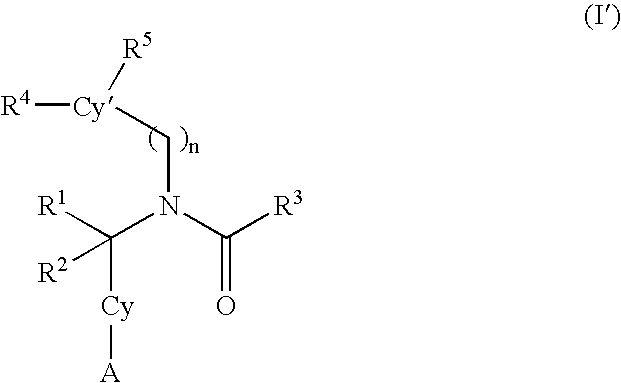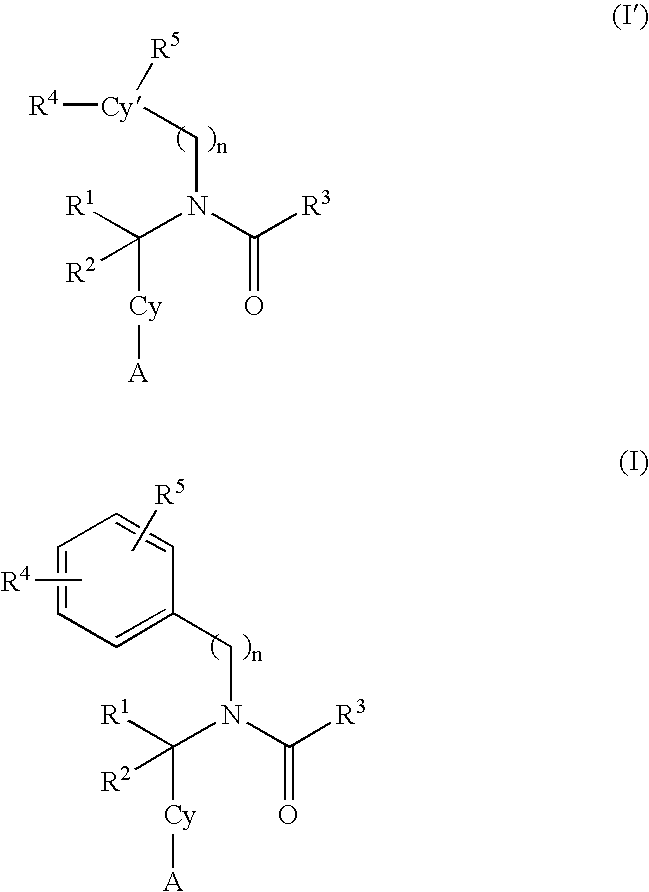Alkynyl aryl carboxamides
a technology of aryl carboxamide and alkyl aryl carboxamide, which is applied in the field of alkyl aryl carboxamide, can solve the problems of increasing the risk of coronary heart diseas
- Summary
- Abstract
- Description
- Claims
- Application Information
AI Technical Summary
Benefits of technology
Problems solved by technology
Method used
Image
Examples
example 1
5-[(3-cyclopentylpropanoyl)(4-dec-1-ynylbenzyl)amino]-2-hydroxybenzoic acid
Step a) Formation of 4-dec-1-ynylbenzaldehyde
To a solution of 4-bromobenzaldehyde (30.0 g, 162.2 mmol), 1-decyne (26.9 g, 35 mL, 194.6 mmol), CuI (309 mg, 1.62 mmol) and of Et3N (68 mL) in anhydrous THF (450 mL) were added PPh3 (1.7 g, 6.49 mmol) and Pd(OAc)2 (728 mg). The reaction mixture was refluxed under argon for 1 hour. After cooling to rt, the solution was concentrated under reduced pressure and the residual oil was dissolved in hexane (480 mL). The solution was washed with an aqueous solution of HCl (0.1N, 1×), brine (2×), water (2×), dried over MgSO4, filtered and concentrated under reduced pressure to give a brown oil. Purification by chromatography on silicagel (c-Hex / EtOAc 20 / 1) gave the title compound as a yellow solid (34.7 g, 88%). 1H NMR (CDCl3) δ 9.97 (s, 1H), 7.78 (d, J=8.7 Hz, 2H), 7.51 (d, J=8.3 Hz, 2H), 2.42 (t, J=7.0 Hz, 2H), 1.67-1.55 (m, 2H), 1.50-1.38 (m, 2H), 1.36-1.21 (m, 8H), 0....
example 2
5-[(3-cyclopentylpropanoyl)(4-dec-1-ynylbenzyl)amino]-2-hydroxybenzoic acid. N-methyl-D-glucamine (i.e. 1-deoxy-1-(methylamino)glucitol)salt
The title compound was prepared following the procedure D using 5-[(3-cyclopentyl-propanoyl)(4-dec-1-ynylbenzyl)amino]-2-hydroxybenzoic acid and N-methyl-D-glucamine as a white powder (93%). M+(ESI):504.1 ;M−(ESI): 502.3. HPLC, Rt: 6.1 min (purity: 98.1%)
example 3
5-[{4-[(4-butylphenyl)ethynyl]benzyl}(3-cyclopentylpropanoyl)amino-2-hydroxybenzoic acid
Step a) Formation of 4-[(4-butylphenyl)ethynyl]benzaldehyde
A solution of p-bromobenzaldehyde (50 g, 270 mmol), 1-butyl-4-ethynylbenzene (47.0 g, 297 mmol), Et3N (540 mmol, 75 mL), CuI (0.52 g, 2.70 mmol), and PPh3 (1.42 g, 5.40 mmol) in 500 mL dry THF was degassed for 15 min by passing a stream of N2 through the solution. Pd(OAc)2 (1.21 g, 5.40 mmol) was then added and the black solution was stirred at rt for 17 hours. 1-butyl-4-ethynylbenzene (4.3 g) was added and the reaction stirred for an additional 3 hours. The reaction was filtered and 20 g of activated charcoal was added to the combined filtrates. This suspension was stirred for 2 hours at rt and was filtered over a pad of celite and reduced to a dark brown solid. The solid was taken up in DCM and added 100 g silica gel and removed the solvent. The product, now disposed on silica gel, was added to the top of a silica gel plug, precondit...
PUM
| Property | Measurement | Unit |
|---|---|---|
| insulin resistance | aaaaa | aaaaa |
| resistance | aaaaa | aaaaa |
| concentration | aaaaa | aaaaa |
Abstract
Description
Claims
Application Information
 Login to View More
Login to View More - R&D
- Intellectual Property
- Life Sciences
- Materials
- Tech Scout
- Unparalleled Data Quality
- Higher Quality Content
- 60% Fewer Hallucinations
Browse by: Latest US Patents, China's latest patents, Technical Efficacy Thesaurus, Application Domain, Technology Topic, Popular Technical Reports.
© 2025 PatSnap. All rights reserved.Legal|Privacy policy|Modern Slavery Act Transparency Statement|Sitemap|About US| Contact US: help@patsnap.com



